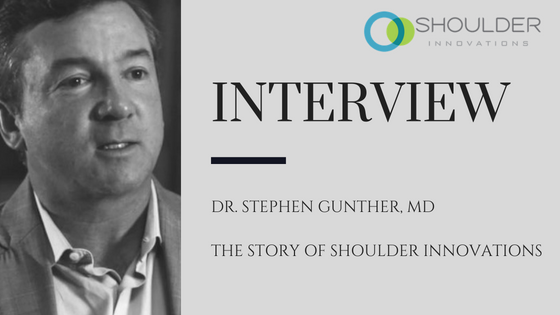
An Interview With Dr. Stephen Gunther
The Story of Shoulder Innovations

In What Ways Did Your Background Influence And Lead You To Create Shoulder Innovations?
My background is in the science of orthopedic surgery.
I’m a third generation orthopedic surgeon. Both my father and grandfather are orthopedic surgeons, so, I come from a long line of orthopedist.
There’s also a lot of creativity in our family because the other half of the family is artists.
It took me awhile to find my particular passion, but this explains how I was eventually lead to academics and then the design/innovation side of medical device.
I started in academics teaching at UCSF, and I was the Chief of Shoulder Service there for four years, which was a lot of fun. During that time I saw a lot of difficult shoulder problems, and was able to write papers, and give lectures which I really enjoyed.
I also had the opportunity to work at UC Berkeley, in the engineering lab, which is one of the best engineering places in the country.
We were able to do a lot of polyethylene research there. My partner, who was one of my mentors intermittently in research, Mike Reese, developed a polyethylene lab at UC Berkeley and had a lot published out there.
This experience was what got me going on the research side of shoulder arthroplasty surgery.
When Did You Come Up With The Concept Of The InSet™ Glenoid?
Later when I moved up to Northern California at the border of the wine country and the lumber country, is when I saw a lot of severely deficient glenoid bone related to shoulder arthritis.
At that time, I figured that these current solutions for shoulder arthroplasty in the setting of deficient bone are just deficient. Then I started thinking that the current fixation of glenoid implants in shoulder arthroplasty just makes no sense because it sits on the surface.
So between looking at the mechanics and trying to figure out how to fit something into deficient bone is when I came up with the answer of the InSet™ Glenoid, which kind of was a simple thought that made a lot of sense in terms of insetting it in the bone instead of laying it on top of the bone.
When you lay it on top of the bone, we have limited fixation, one. Two, you have limited resources for improving your fixation because of deficient bone, you have less and less bone to expand into.
And that’s what all the current implant companies were doing. They were making more pegs, longer pegs, fluted pegs, anchor pegs, et cetera, and there was just no room for any of that.
To me, it didn’t really make sense for primary cases either, because if you’re just trying to take up more bone whenever there’s loosening, or infection, or anything, the whole glenoid vault on the bone that you do have is lost, and you have a big cavitary defect.
Between all those ideas rolling around in my head is when I figured out to InSet™ glenoids specifically for these deficient bone cases.
Then I invented the implant, wrote the patents, and was able to get an engineer to design it for me. I told them what I wanted, and then I did a whole bunch of cases as custom implants, and that’s how it all got started.
Why Did Shoulder Innovations Partner With Genesis Innovation Group?
There was a natural fit to partner with the Genesis in order to take Shoulder Innovations to the “next level.”
Genesis has some of the best shoulder engineers in the world, who had left some big companies in order to create a startup, incubator-type company to bring medical devices, in our case orthopedic implants to the market.
So it was perfect timing between what they wanted to do and what we were already doing.
We had technology that fit perfectly with their model, and they’re the perfect on-ramp for us to go to market. It’s been a great partnership.
This has been a great partnership. The Genesis team are great people, they’re hard-working, they’re very smart, and they’re a lot of fun to develop a real company with.